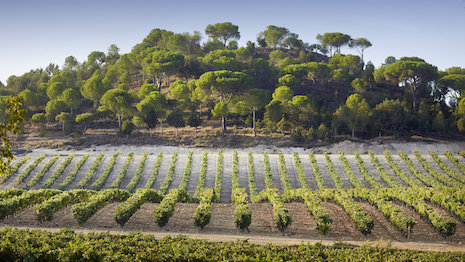MADRID – Investments in high-end wine may not be as lucrative as they once were, but the beverage industry remains a low-risk avenue for affluents to begin experimenting with investing.
Per a panel on May 20 moderated by Financial Times associate editor and chief economics commenter Martin Wolf, the global wine market has seen recent changes in terms of both production and sales, at the FT Business of Luxury Summit 2019. The largest producers of wine are no longer the biggest consumers, although more wine is produced than consumed worldwide.
“China is close to overtaking the United States as biggest market for wine, if it hasn’t already,” said Jancis Robinson, master of wine and wine correspondent at the Financial Times.
World of wine
As of 2016, the global wine market was worth more than $288 billion according to Ms. Robinson.
The U.S. and China both have wine markets valued at over $40 billion. France, the United Kingdom and Japan follow as the largest consumers of wine.

Many affluents show interest in learning more about wine-making. Image credit: Four Seasons
While European wine producers, including France and Italy, used to be leaders in the consumption of wine, rates of wine drinking have declined because of health concerns. Ms. Robinson said this is especially apparent in Spain, where young consumers have begun to avoid wine.
Other markets, however, are showing continued interest in enjoying wine.
Vega Sicilia, a Spanish winery that founded in 1864, makes 10 percent of its sales in Mexico. With its reserve bottles of red wine selling for upwards of $500, the family-owned winery made $1.2 million in sales last year.
Antonio Menéndez, Vega Sicilia’s managing director of sales and marketing, attributes the popularity of red wine in Mexico due to the country’s strong Spanish heritage. Switzerland and the U.S. are also large markets for Vega Sicilia.
Although China has a mature market for beverages, selling wine there comes with its own set of challenges.
According to the IWSR “Ecommerce Study: A strategic roadmap for alcoholic beverages,” China’s ecommerce market for alcoholic beverages is currently at $6.1 billion, four times higher than the United States. Wine is the most popular form of alcohol bought online, with a typical 60 to 70 percent share of sales (see story).
“Getting wine into mainland China is very difficult,” said Simon Staples, fine wine director at Berry Bros. & Rudd, noting the duty taxes and other complications that come into play when importing wine from Hong Kong to mainland China.

Wine production is on the rise in typically cooler climates as global temperatures climb. Image credit: Berry Bros. & Rudd
Furthermore, climate change is also impacting wine production.
Ms. Robinson explained that rising temperatures have expanded the areas where grapes can ripen for wine production. She revealed that wine from unexpected countries including Canada and the U.K. has improved in recent years.
Vega Sicilia is also producing dry wine at its Hungary vineyard for the first time.
Beverage investments
Changes in production has also changed investment strategies.
Mr. Staples primarily invest in wine, but laments that there is little worth investing in from regions such as Bordeaux. He also encouraged newcomers to invest beyond legacy labels to achieve better returns.
Whether a consumer is looking to begin collecting or uphold an established collection, being privy to insights regarding various types of wines and their worth can be essential to profitability.
The Vincast by Auction Forecast platform tracks data points such as auction prices, collectability scores, market indices and return-on-investment forecasts to ensure the collector that they are making a sound purchase or fair sale. Vincast’s premium features include tools to determine bidding prices, ROI graphs, collectability scores and elements that track the market index and scenarios (see story).
Other luxury alcohol is also worth considering for investments.
The luxury spirit market has seen healthy growth over the past few years, with sales of whisky and scotch remaining strong and some bottles fetching record-breaking prices at auction. While overall vodka sales are down internationally, the most expensive super-premium segment of the spirit was actually the one that experienced a remarkable 15 percent growth, according to a 2018 report from the IWSR (see story).
“Whisky has shown great returns,” Ms. Robinson said. “Gin is also becoming huge.”
{"ct":"VjwJtWjDITULkCjAx+1JSZW9CHDibkR+7jW8N9pZ+qAN828yIX88OXwuPFR\/WWSuCB3\/CLqMN4qgiM9CiAehRjdewsvhnKifKCUAq61wlm8eq+fe7GoQqi6V089jkhBqdZ3G+7PMKJciPjFtgfXBdTnooVfcSnmXSAaqCGf4D5fzenchPbEQIv9y1w\/fH8Edd96igqAuFfe0y796gKFxp9Xi\/BZ1woCErCKC1Q8+mN\/tJC9a2bJpeTe7ZNXjZwlht+EX8kqtBpV6zNELDeRG3wR18Vs4iVZCSUvmON3l7Q2L2MNy+duum+t80PsY0C2tamusRbb\/JYEE701jk9KhhhdSVKy7Bxsfs1NaxDE\/ZQnU4++p+WTBDhw7+DDMHiIUGTfGDFOS0\/4lt0ho0XgTynOimJAMK7YLJpDITn1wqvcXS7QeOtyFnoD5wSamrJBuoId2LoEw3BqZ6ijBbu431dZ0dBoa+78TZZLqpxbMSR66UDlSBrH54ldxhx6wVBl3eqd8wRKvb0jW1csA6i8JXmxsEPcM5kZersPKOfpmhbCnqsW9RpBzYoykpqe+Xr3OZjAot05QJ0Rd2ixioMgEXcUWjmXnKhfq8hAro\/ytD4THfsBl92micr9JsO8sAA2fH18akfiZ9OAKCgQZ3uaHX5gOhtrZhfU2x3ADBiYNp8gQvGVMHD0fDU+bnPoRw3VNGbRgl00UF3PKTQyM0pi2TlMCmG8+AMoDIWJohfXbuDt\/cnd1Y\/+M5tdBoo3IxCIBwB7mznExuNVrVVrAYWMl6HzS6jx6p95glrB4LV6kGEMPHhIVUkT5X9GEAwoqd9vz5ANRQG7gLRVEnHVjv6jrU3zLaPvtktbTxD6bfU4WM1+L8eB5eibTE4\/J4ABktTpzFei19AEZxKuHKllvAhB2cZWLFE5eGc0gGyE7usieMG1lhTU0zNHYQjRY7jMKmInN26fyVMadYABr9BLdIbSvDTSLodka3v8osQUji57nXPoFr1PfBf6ERG36ZgBozOS+XlM3jULwjXUwbwnGJeqyLCbDfIMqfj29eGavoR4sGHfsFTqmxxRWQifRAhYleDSRuFrrVMkwrlnWpdtIJTtZyX6kiXZ34SRTjbjHwT4w4xxvukL1GLI7ENG4zQ3OMNgwhOvU+YEQa4zLs1nQXbp0XQ6TTLcOKfH51k\/IyLma+UmyTatN\/TwiOt5rL2k4ccBXT5utI4hBAeRnv+G8y5eIkcKsPvjr5n7sf4RppA+QyF1A13SCIdLJo97RImmpS\/0TY7MSy38H5ZmMccxSnQYMeQQXdMhbeb5f5gx\/xc2S8yi5JyrxQzPCe3ZwCyWcfdFpBBT91FoDcX\/FC0uGTR35l9ohIicUVxrusiDw8vtWSCGD8UBUyqjcneloTdqoTa+XjHdHkSD48FXrVHflW9S33K7gkpxOjU48WhTGFJ9dJfeBv7YRcf+DXgCwTxPILwNMT\/wIc+rjBEzLXPjKmKARpp0DNEwMmFc8OrmKhsBNgyE0i7HF1Zp3Ig5onKgIOjk1iRuQkSrnb58C+FfIRxcGsUiAKNRLkfRfVdmJfAOj5XtBJ+1pYbwlg2Y91fbCe9gQlAxgT+gYBsPLuINFvXxGzP864RmXwr458DjFLzv4Cbt1XfSik5oiLTpmTpQcF1SODbv3kazMj+AQeq6xwmQVXJCuFadhMWgzNUnUotktHz2sF6diu6oQmJq48ZlmefxLqn3S8ytgMf5IMCWu\/SWz9\/JRqS3IYkQV3I+Je6RoOzdGP7+p3Zszt9QWp2S+xaToiQt9wosnY+0s1EhU6vH\/W6TjOl7\/CnhOhhKu5gYRRywbkXjhbK6Vszbzyju1G7cCel4s5XY+qL\/7AozF\/5NDEMfHiEjHg0W\/h5CEBb+g7gXhhDyPYk4KNSJRxxX1HbTAPtgWMZhVh9SEyHIfMZdacMyH6W46LmnNcByWx5B0NBaW\/rxHZ1D6r9i9upsYCa\/rWMM\/kpDWmiRH7DnIW+0Qq5rRasE\/aCO+0+DUWGlGZ75hZspcXK3XzwZo5R7gsFFmGzuTl06zcr0DUsAi9N7aBaBGK8LpNRgjbXRmJ\/0SSk5AHkT0KuYYqa4KEGp+qUOATcMNgCpIzSkv8eZSZS6UDJIJCte3DK0dES1dcNPJHGoLKGzYRd9EIBFRWC2ioCC\/OkBvZaSlTBmAIgr\/vFg2buTmv0EZSM\/JmfnQAvoiidVk4v9RXPr1w2zM25k34Ba0uMB33MM3gm+iqRrDUFupkB9bhwvFkh56JP4HmR5KrmTbAFHhY4oqmUTzNEsO7RVBRO6fO0Nx\/OpHQ76PGuxA717aAbG8ScDSf1oWeSv5dyWfqgKk4KbVFVdBuHx2PzXdoN0DY10nMRWeW4r4omdA4It5wOVvQKTa8Loqm\/9szL0IiZargI1IHDsCvWVJbCL2SyKmPXCFd2btHWgYm6RVPLwZw2BN3J5\/iMoaGuWSkf3o\/nhfD6ih5o\/+cuJCvRkTvZrnu2CrPypDH6R6dbY5YayVnK3npbZjkyI+U29eHbcwCWaOSFr+\/VfLnt1A9NC0xjD6rVrLpByvZVJ3JA0zTBJlbtLdm9tbao8GrnzxNK0WiKyTYz8csd4mg\/Db4QyEvRrFXf5fw6\/iivIG2g4QY\/j7VuP5xicyqymHjeFKhmtvPnf6Bol\/IYDbmDsL1Ur2+8yoEFlGronu5B85hJgA\/74xWCSnooDhyqFBmXbGr47LvE7jlH70D8JFSKrmIK\/x+Qp3EYtrsPOJg+\/GkVCM2uEO5NXkrGLzhjgo0RNY78BvKuZypSl\/CqwPyL19dA7CkuWhlr4HWifGzNtNg43jI3Zgpk\/vLypXjNbf5lzUGrrDbEhNozfULzq6xa7zMFqV0GY4Zx3lKsMtrBAfaa2CCqoqccs1L1Jez0YrACtRG\/tdoQmGL+3\/Pzl\/dlVfxK1vwg23BwhDGaqHVLsKLb570\/VVIrqHM7xM2ww8BDohI9dhcajMA9cV2nAyn09BS8UTyXzVB5Fron4k2m+x70cO4HVSBp7kTmrDDtKr5iOBh1HPRKKx5CbV49XmbwphZafgpRyr4D1eOOY8bDtfcpzO2kksE5XX3iKnMYQ047Xb4oTQWm3HO9OYEh2rU\/5hp2aUsxYx9czJabpMftMTDUSNl697ywIzXB0aD0P8AFtyHBD+X8YMhQWyN\/KhyzXdkAFkaOw\/qz25MzeEq0UB35x51acDrvOTU3mvciXKcGvuAKEDlW+N14lYSkfxth7q9JbASgkZKyLZe94HI2HMAPpwp6TCoQZXwACjfllQTJc+d+BJrv5Sp+WZYaAdBQyBvg454W1BdG45ay8MyBIJ6G\/eazwOlOmkOXnCvLZDrwggcp25ZTTeryGfQnj7eaQsWXoxsC4AV7cBIj4Oe8LHum5oXhLDlyT3rmYQs6dBh5r8KNzxsJ4wlfP1u3lIAJcmhoLkyqYXdtpoIPtxE56og\/ZJV+MDidGE2VSfCNFEcWcyDsHFf7LVNkSK1b7lQrj2UbPbN82Xdqe+AKfg2yyT1sC5SWf36cNHXVTr43\/KS\/DrIe7ThcbRZPRY2cV2YQk7MZ18WFUEyZgcfY8xHWHcwZQA03gtJyMGecaoe\/AZGh8pQHthYXYijcfnUanJnTdsO8PZG9DOseAFDagr8n2\/q9+ANHht0yTGqKa\/lZ+Na0Fk\/solYvkr5obeH3AgG5pQ4bvyCBXlrdxm4TbVa943moY4OLGwUUvwn1KxIvI46f9O0TQNlSWS4j3cTau0EvcfRHaF5U11olRh4aLl35wfV5IvV5u443I8r5gi7p7Aw12YYf\/ptuk3EjO6RBBO+mGsxw5SXEA3zCKldvGp+q\/Usx67\/SnhYc3abqlsKBA9CLBFe6Uq9MfQma8Neyvbj\/NI4+fp2OVzeqXeVpAlBTFhfj7i\/tNeYJVENiy3CTarCKSNYnRhlRafYKAvBTLnmDtnGdQc4S7ZL+NkvSrXKyhvmTbCLtzR3o5dWD6MqYZwP7i4acH27C2MLcu5Kk909uVkUvxjgVT55ZUgYuIMusrgrqg+9NAu1p5dDwaWae6CENgtWydKt8L5AMYmAOU\/grfy\/dKDQhFIig9LFvI7gVCHa0Gk8DXE++UNnuU3shtrDcykGjvRciAY6IDM8IKHltl1WCzCZvMhCiY1Wb1zYKWOOgnZmiEAznxbPRPZ1XPvoH6VAZbiRxb9H0Abbi0wavaldJY35ZzNYEwjvZMQHLOGbyEvSBuERPDGRSFrxbO6QC+Z1ECQKb1YPa4q9dVTw7sJTCMusRj3hJqvHCr\/FAK7p\/+g+eLPMNeLQi7SH0vMKKTP7wHEI5RAQrGHyL45FK3mQl3\/w\/20WICPt8xRm82NQm2Lha39dAKiuT7qFq7o7mR4XaSVGw2jdsun42uMMd0PkUrut12+rkCV+KL6uULQyamgpMbWxE87exzRDQ+YVbI7Ghw1OTVOHWcElKbR+eZZTE2aGt0RZva7JJ2rm1ottNHODExIj54FS6o2qY1nnW7nHOHv6OR7zRFcv5D731s++I1SVbdJkA8Jl8T07TuIEEc5rfx9AOblvg7IrEQlqsajsrmnd5IFkiRgdoGXXOAv2xrt1Z8S81NCmjrvAL\/5ef9zDWkHiwctHuRLP5JK3DAcyKVW+prruWe7A7PEaeZrblpYDgDOlTfaH2mGo+Oshx9jIk4dMh8N6jBnOlqNBizIKB0tfAaS2rgTVPjwVIaNSInjQsP9wrdv91GnBlryro1DW4cIjTEpGYcBaQqf5W5ZjbqdgIxHXHTeh+ZISrr+2P\/fpXtDxaK0rr9LRKugoYjyFESujN5RWX8u8YjmhkbLBTyMNBIxfDrL8P0oH+cEKQo7W3qqExgdMD1q+BkYAZPUuw\/pRp1sxHHGFsC\/lrr0lrrHW7nZEY3gQFrd1nzZqTW85sE7tHN7ybBIGeZGfbvECDFoLfBpo1Hpf3l1VVO8sEJkynvXLbpn2+c9YtEVnIriRq906XaktwMtvZe4jEne7W3Sy12dTXiGuoKj4xUOZ9WKDwuGpH+hGtoztaraQI+UZN92GaK++v0dplzZFMx0OT4lKGZsqUGagCi8\/EYktJwKcH1ge93fLWshWpqmAJt4ae8khRIe8wLMqXETJSTLpB2tHc75gi4vQA3719T1F+cGc+WdoyC3NAKe3Rr7zPzHdijsLW85Ilgcio7ia1GUM+hzvCp+t7O2\/8ft8lED0fA\/HdmSY7Cl5hROO\/ImkGoNbkL+4kozPn8hWjut5+nhgdqNspmk7Ih3kl0BN2B9njaxx8MjoIDomBrW1QqGhMRpZatRvcOvqAriRhLPTwABW98sARDSpr3KerjddAeMHr6PCsDc+q2vct6gsoiI+pcNksIzCFhHeVjQTafaOYw5HT\/dlzXhp+Vc9n2JHFzFDJbMD7q6HrU9xtWJwbO7MBOvGYTKB1fdgvTQGP71XNhW23Vvqt8PrjyzJpz67MHtFC5Qs\/wlHyQqgYgT97Y8MfD2l8Ef0Sl35ClYdrqMGgwh5qFUayZFtEGJUNu\/zb0zBPEmxny5E\/gggItbRH8KCXMRHjROeZwxDG+NyYghx1vEM7fg25\/wKUqs4aDfwgIdzHrZESQmfQzQ4P5Y9KeiJyVPHRsRkNDx\/8HPhcwuq7fcvw\/Nb5yn77FlCNhJq9rBf2Zdl9bYjbZrhJLO3xB5wuHoqh4R9jcOdYRT9TR5YlyqfVBB14pm7HNLWV8s1xoM7EtwN6YCyB8yyKua1D5ry5kGuolrrtP26U5439pkX9V3UXIyz4qAlHcgNLfFDnwWSc9zpCdaba1+zf9w+1cpEa\/x1xhblmOuseX3PueZhMwX4DyMQ2dSuELnj0aUd2l+K5Hr2BTTfS4a67z45MD5H1DW7xH7Nek2xnSzrrD6rZHMDidBZeKUryF0tqNkpROyM\/vhAWGpoFxijfZiw6BBxfcsLnbdheGn\/GR5fdIN8QjxcPHiHae57KSwwZhzskL3gJisdDNnuzTlueXhXx\/6wKBZxFab\/5qnn29l3aps5rT6Bt5LnToLZb2UcryFvaJvlYrQORq0pm739YCdkL\/cyO1uK2SrQFo2fzrcl9J7onsIcSc56ofHw3xHHhGX66GkFTT4CM\/bQznNCQANC75dYPwZVRNmvykELL3n1C3E4jVdg6vXs2p2EWwkhDIMVd02YVKsn++ShuZBi6Pa7IqO6lOMVRM1VCEdetsI9SS6yGiw4g0GEeof3oz4wMk0wLOH7xxbmobZXCLmX8zEWeZ1OgzVE481kACr1z7y\/BvgqrmldDNcVaNFjBOLVPt5eKnQ6THfrES0dXhFqr09QNlfj0v90fSk3MSJFPhS5a2Ue4nQgcIWZ\/U\/cZfcWgnE20woU4CbxvxPzPdLJF9wzVfOIB8uXBDncWpxctj05vKQs0LUs5lIJEIOrPLnVGHRWz4r+HK9zK0I7bvpjPX2HmtLREqeOdQFUfe3qUajq+EC74\/oTRsmUggEpNe6Gvyf8a9KQystTVYgPPHoQ6GvutPL5UDe3P149aONv2cA2be16P2V1nNw3TUJM8jICB\/RLttorzvmd19nX5vK5rDaYGm3ekFLQEVli0\/LPlCpdcMhNhHw+aAcbrNhKPLjU+zAz3IHjNucHMx8UAhqkoFjO++7X290VA3DtPIc6IwZqUt+rarpi7MBFv5c1pjbzDNvyyUEDV+lQJswy2wjy02H5y9ZVDXuILN4wk\/EA+AzqeEPCWMml6gVwOaAnXKnecB4PRpNpYB04KYzqc9LaIuiIqGV5LIQFair4qKHiGC1ecrz9uPaXGBKSb5vpmT86gT8ovTx3\/0TliUIDzta7TmzwPOmIjsAaOyY\/jEeOXdl14n74pesiBvQ6ndTy9YgVUk1LG0VbNMhjsp7kD187LCbmO6ErvOYSd04liKj1xu0XVlHou6ZAWzxI8FgDekx369QKrzUDKNrnrOQj6TnSzb0WaOWv7BxjLD2+ojDdslP0YJA5JWNuKJgAM31JZWxNjvIqP7Mv6JHRXVVh9xPqYHPjnB5epUjuCLjozTWNbA03f6LFVKUZBfJoZrKbzPbIVFbCuR16CJsdfxgR\/MkZH7A3ni3QJoSzO08\/tWdZ2AEUYUxvMuIan+386lO3QqLI89IByzVWUtN+0\/arWypZhlzyQZ\/Ur8G6a7KIpVXXEFM6UkGD4abMdzXknaW\/s7wpH\/bxwjKOMTkheWCQ4nWuT5wpJGYuydQrwEhqGBWoTLBtmO8Q\/m3lp3y3RS\/Sr7teYvcavYa4b8DU4ltaL4qrbAFY5fqhdDGzzbzpbyzmACjJqWuLpYuT\/iUfcWKTP8TBCgrH4soiZZNEwcTqs1tuDJfWbbJmsZHATK32svx3RWUcH1T+glvvI+boA+vBR+Oq1YWIIjhJ7qxk4wMho7iCxAJZ+8\/HNFCcLypg9FUfJ5evo0U80Bwg0krEYIe\/sDBFtaL4AJ+CbD\/JFu\/ZcfVrSSFdxcbMRVZe2E4qQuFsZCjFsfeRaK4PeLY3qkTaSjsxv4Ov6qr8htUws7iuhi7kqobQuEou2T0niTMvbTbp7iSmBgXekUd5xRHHkleOo97iw0xuQmLnoQxTwDE1lai6VajX1PXQIlY5BhJZ\/1Vu4NuGVWI4V+VGkc39kVjY93sni3G+jN0vzUKtXvMn7iWrPffXgTHqsVylXLOWUnlMKoN74M6\/SIFz4ZKzNjxe+LESRRhBval2dKjjIOdydmEc2vmWJavztcoRhHU84dQnvrTRqTdLdMuXC8Dwk4QNFyFLELvIuu4NvJN3ljH74C8onJZEWHVbNniv6\/6IRRGq3axcLbZFYTC6whm7RjumuYUGlivzjWPFfF4vob8wQY1kCqA7lPRps9zUX+a9jfOXnnReBVj8Okm9wze9POT\/2\/SfD6CMkM4VWhFJSpLP\/fcXLoB6noqloUia+hUvzgHgg4ZIL+8hCOIEPURte2ATRu4SCTM2t0LBt17oCKzqLY+gU9Hvq+\/9yJgS0fdXz4dAAhbcombo63zN+Mi9lXBeoY6ULtZbSTRSt02oMRPVOEasCXeObu6UocGjqLpgCasUKBZjc81\/7iYrLP85gHv73Dv9AeKdrkyK1p5RHsT2cRN8Yua1WyJLXgFkcVeHiEPlyuqQJzdqpStSEGIT0SuyboMd6ALff6W111cFyu+t4fWrpfP\/sleWSfhPrSsYQYKjW5tSkVK4HydCkL8nQ0cfE2zrjT2P3gjPkU=","iv":"1618eec183c009e85d71f0466120b7d1","s":"6f1598735061451d"}

 A Vega Sicilia vineyard in Spain. Image credit: Vega Sicilia
A Vega Sicilia vineyard in Spain. Image credit: Vega Sicilia